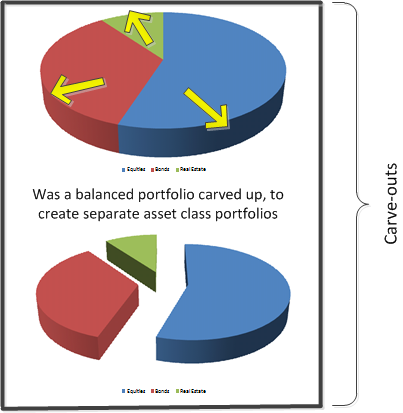One of our verification clients has the following situation, which I think is interesting. They have a client who has their money invested in three classes: equities, bonds, and real estate. Because the firm wishes to utilize carve-outs, they’ve constructed three separate portfolios, by asset class, so that the cash is managed separately. And so, they have four composites:
- Total combined strategy (balanced) portfolio
- Equity portion (w/equity cash)
- Fixed income portion (w/fixed income cash)
- Real estate portion (w/real estate cash).
This raises a question: are they actually managing a “total portfolio,” or are they managing three separate portfolios? This topic was raised, way back in 1992, with the AIMR-PPS(R) standards. In a Q&A booklet they published, they raised the point about “who controls the asset allocation.” If the client does, then one could conclude that there is no “balanced portfolio,” since inherent with a balanced portfolio are (a) the management of the asset class investments and (b) the allocation of cash across the asset classes. The reality is, most managers disregard this, and if they have a “balanced portfolio” that includes two or more asset classes, they will move it, en masse, into a “balanced composite.”
Here we see the bringing together of three portfolios to form a larger one. And so, I reflected on this a bit.
We typically think of a balanced portfolio, being carved into separate asset-class portfolios, as shown here:
The pie as a single portfolio can be a real, single portfolio, or a virtual master portfolio, that consists of three subportfolios, which are kept separate to facilitate cash management (recall that under the new GIPS(R) (Global Investment Performance Standards) rules, we can no longer allocate cash, but must manage the cash separately). If the situation meets this form, then the three asset class composites would need to indicate the use of carve-outs.
Alternatively, we can view the balanced portfolio being constructed, as follows:
I’ve coined the term “carve-ins,” because we’re taking separate and distinct pieces (like a jigsaw puzzle) and bringing them together. An analogy might be those cheesecakes you may have seen, that are made up of slices of different types of cheesecake. The pie was not made this way; rather, slices from several different cheesecakes were brought together to form it.
And so, in this scenario, we took three different pieces, and brought them together to form a balanced portfolio.
IF these three pieces were not managed collectively, but instead individually, then this arguably constitutes a hypothetical portfolio. And the Standards, while allowing the use of hypotheticals, doesn’t permit them as presentations that conform to the GIPS rules; they would have to be labeled as “supplemental.” That is, there is no management of the collective, but rather only the individual parts.
Asset managers are sometimes asked (or choose) to bring together different portfolios to form a single one. Think about a manager that has a global mandate, as well as an emerging markets strategy. They may choose to combine them, to show how they would have done, had they offered such a strategy. BUT, they didn’t offer it. This is hypothetical. Yes, they do, in fact, manage the parts individually, but there is no active management of the whole. And so, its combination is hypothetical.
Likewise, if our client didn’t manage the collection of asset classes as a single portfolio, but rather was given three different and distinct mandates, combining them, to form a balanced portfolio, would arguably be hypothetical.
Let us know your thoughts, by commenting below.



